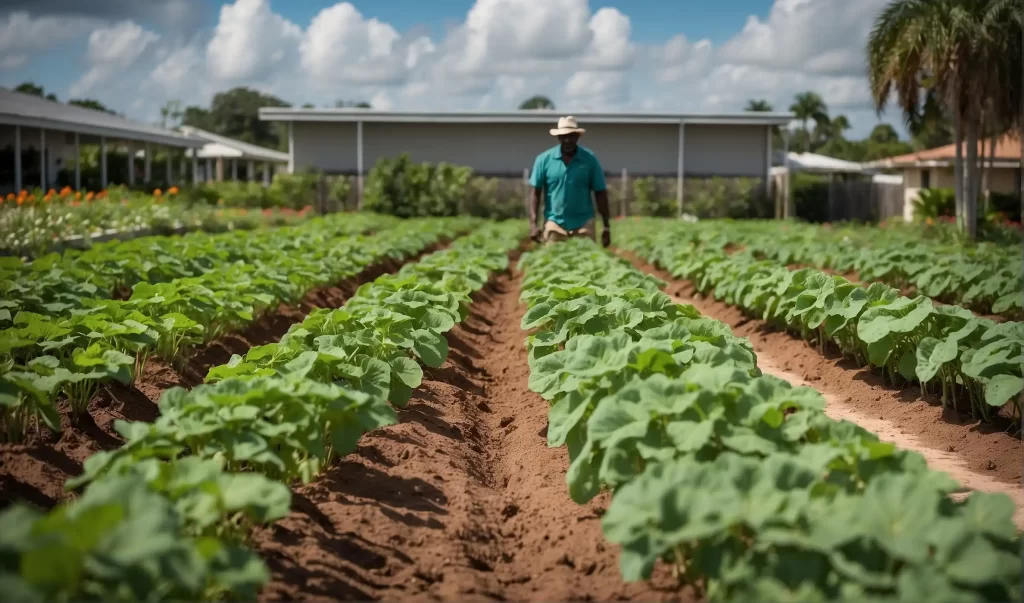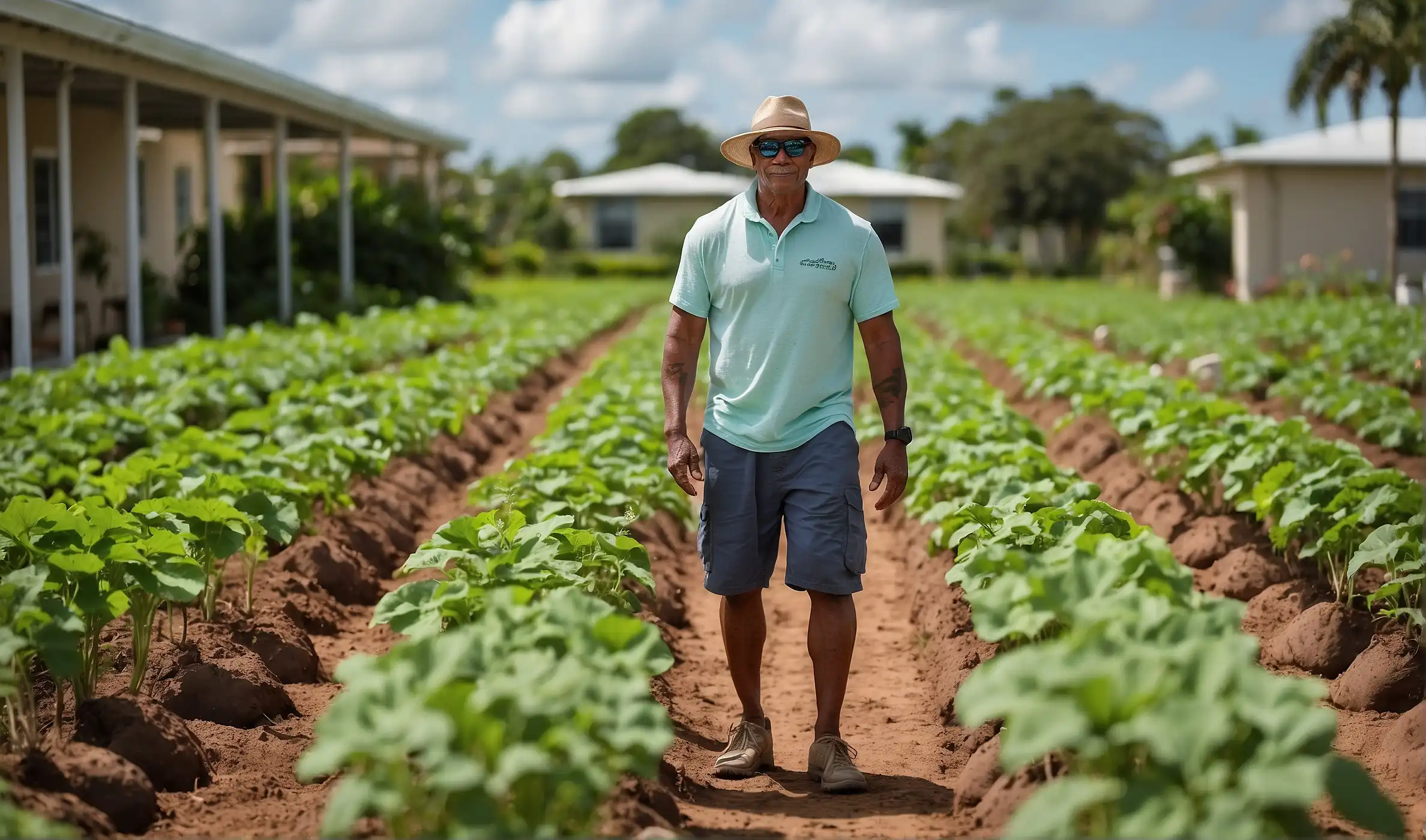To grow sweet potatoes in Florida, select a sunny spot, and plant slips after the last frost. Ensure the soil is well-drained and sandy for optimal growth.
Growing sweet potatoes in the Sunshine State can be incredibly rewarding, especially with Florida’s warm climate providing ideal growing conditions most of the year. Start your gardening adventure by choosing a variety that flourishes in warm environments. Prioritize soil preparation, as sweet potatoes thrive in well-drained, nutrient-rich soil with a slightly acidic to neutral pH.
Sweet potatoes require minimal maintenance, but consistent moisture and weed control are crucial. With just a little care and the right techniques, you can harvest a bountiful crop of sweet potatoes, bursting with flavor, from your very own backyard in Florida.
Sweet Potato Cultivation In Florida
Sweet potatoes thrive in well-drained, sandy soils with a pH between 5.5 and 6.5. Begin by clearing the garden area of weeds and debris. Introduce generous amounts of compost or well-rotted manure to enrich the soil, ensuring a fertile bed for the tubers to develop. Make sure to work the soil well, creating raised beds or rows approximately 8 inches high to improve drainage.
Choose varieties suitable for the Florida climate like ‘Beauregard’, ‘Centennial’, or ‘Georgia Jet’. These cultivars are known for their heat tolerance and disease resistance, crucial traits for successful growth in Florida’s conditions.
Favor slip planting over direct seeding for sweet potatoes. Plant slips, which are young cuttings from mature sweet potato vines, after the threat of frost has passed and soil temperatures have warmed. Space them about 12 to 18 inches apart in rows, ensuring each slip is planted up to its top leaves to encourage a strong root system.
Full sunlight is essential for sweet potatoes, guaranteeing at least six hours of direct sunlight daily. If intense afternoon heat could stress plants, consider light shading methods that do not significantly reduce sun exposure.
Growing sweet potatoes in Florida

Provide consistent watering, especially during the initial growth phase and tuber formation. While sweet potatoes are somewhat drought-tolerant, they will produce bigger and better yields with regular, even moisture — typically about 1 inch of water per week, either from rainfall or irrigation.
Implement crop rotation and use certified disease-free slips to minimize pest and disease risk. Regularly inspect plants and address infestations of sweet potato weevils or fungal issues such as black rot promptly to prevent spread.
Harvest sweet potatoes before the first fall frost by gently lifting the tubers with a spading fork. Cure them in a warm, humid place for about 10 days before moving to a cool, dark area for storage. Properly cured sweet potatoes can last for several months.
Time plantings from late spring to early summer, allowing enough growing season for tubers to mature, which is typically 90 to 170 days after planting depending on the variety. Sweet potatoes are sensitive to cold, so ensure the last frost has passed and soil temperatures exceed 65°F before planting.
Florida’s Climate And Sweet Potatoes
Florida’s climate is characterized by long, hot summers and mild winters, making it an excellent environment for growing sweet potatoes. They thrive in the warm weather and generally require a long frost-free growing period. To ensure a successful harvest, gardeners must understand local weather patterns, such as the timing of rainy seasons and the potential for drought or excessive heat.
Adapting your gardening techniques to the Florida heat is crucial. Sweet potatoes prefer well-drained soil and plenty of sunlight. Creating raised beds can improve drainage and prevent root rot. It’s also important to use mulch to retain moisture and keep the roots cool. During peak summer temperatures, providing some shade in the afternoon can help protect the plants from heat stress. Regular watering, particularly during dry spells, will help ensure your sweet potatoes develop properly.
Also learn: How to Grow Sweet Potatoes in a Bag
Prepping Soil For Sweet Potatoes
Growing sweet potatoes in Florida requires specific soil conditions to ensure a bountiful harvest. Soil composition plays a pivotal role and must be carefully analyzed. Begin with a soil test to determine existing nutrient levels and any deficiencies that might hinder growth.
Enriching the soil is then necessary to create an ideal environment for sweet potatoes. Incorporate well-decomposed compost or aged manure into the planting beds, which will improve texture, increase nutrient content, and enhance the soil’s ability to hold moisture—key factors for sweet potato development.
The ideal pH level for sweet potatoes typically ranges from 5.5 to 6.5. If the soil pH is outside this range, amending it with the appropriate materials, such as lime for acidic soil or sulfur for alkaline soil, can help achieve the optimal balance for sweet potato growth.
Selecting Varieties For Florida’s Environment
Florida’s environment is particularly well-suited for growing certain sweet potato varieties. To ensure a bountiful yield, opting for heat-tolerant and disease-resistant types is crucial. The Beauregard is a popular choice, valued for its fast maturation and excellent storage qualities. Jewel and Covington varieties also fare well, offering robust flavors and substantial harvests. These cultivars have proven adaptability to Florida’s unique climate.
Securing high-quality sweet potato slips lays the foundation for a successful crop. Gardeners can source slips from reputable local nurseries or through trusted online suppliers, ensuring strong, disease-free starts for their gardens. It’s important to verify the source’s credibility and to choose slips that are specifically cultivated for Florida’s growing conditions.
How To Plant Sweet Potatoes In Florida
Growing sweet potatoes in Florida requires understanding the ideal planting distances and depths. Sweet potato slips should be planted in rows spaced three to four feet apart, with a spacing of 12 to 18 inches between the slips within the row. Planting depth is critical; sweet potato slips should be planted so that the root end is about 3 to 4 inches deep in the soil, ensuring that at least two to three nodes are buried, as these will develop into roots.
The timing of planting in Florida is crucial for successful harvesting. Sweet potatoes thrive in warm weather, and the ideal time to plant is once the soil has warmed up in the spring, typically starting in April. This timing takes full advantage of Florida’s long growing season, providing plants with ample time to mature before the first frost.
Sunlight And Water: The Balancing Act
Sweet potatoes in Florida thrive best with around 8 to 10 hours of direct sunlight daily. This ample light fuels their growth, ensuring a bountiful harvest. As the Florida sun can be intense, maintaining the right balance with watering is essential. Sweet potatoes prefer consistent moisture, which develops their signature sweet taste and smooth texture.
| Time of Year | Watering Frequency |
|---|---|
| Spring (Planting) | 1-1.5 inches per week |
| Summer (Growing) | Twice weekly, possibly more during dry spells |
| Fall (Pre-Harvest) | Reduce to once a week to allow tubers to mature |
Consistent watering encourages steady growth, but it’s crucial to avoid waterlogged soil which can lead to root rot. Using a drip irrigation system can effectively manage soil moisture and ensure your sweet potatoes receive the hydration they need without overwatering.
Protecting Your Crop From Harm
Sweet potatoes in Florida face a variety of pests that can threaten yield and plant health. Among these, the sweet potato weevil is notorious for damaging both foliage and tubers. The Southern potato wireworm and various rootworm species are also significant pests that can inflict serious harm on crops. Effective pest management is crucial to safeguard your sweet potatoes.
Organic methods include introducing beneficial predators like ladybugs or using neem oil to deter pests. Additionally, diatomaceous earth can provide a physical barrier against crawling insects. Chemical options, though not always preferred, might be necessary in cases of severe infestation. Look for products with an active ingredient like permethrin, which targets a wide array of insects. Always follow label instructions to minimize environmental impact and ensure safety.
Perfecting The Harvest And Storage
Sweet potatoes reach maturity typically between 90 to 120 days after planting. To ensure that your sweet potatoes are ready for harvest, look for foliage that starts to yellow. Another indicator is the size of the potatoes themselves; they should be plump and fill the soil. As you gently unearth a few spuds, remember that impacting the skin can reduce their shelf life.
Curing sweet potatoes is critical, particularly in Florida’s humid climate. It involves storing them at 85-90°F with high humidity for about 10 to 14 days. This process heals minor damages and thickens the skin. For storing, find a space with temperatures around 55-60°F and moderate humidity. Properly cured and stored sweet potatoes can last for several months.
Sweet Potato Growth Cycle In Florida
Growing sweet potatoes in Florida requires an understanding of the state’s unique climate. Start your sweet potato crop in Florida by selecting the right planting time. The ideal period for planting is during the late winter or early spring months, specifically from March to June. This timing allows sweet potatoes to leverage the warm temperatures and long growing season indicative of Florida’s climate.
Planting in this window ensures that the sweet potatoes have ample time to mature and thrive, avoiding the much cooler months that could impede growth. Keep in mind that sweet potatoes typically need about 90 to 170 days to reach harvest, which aligns well with Florida’s lengthy periods of warmth and sunshine. By keenly observing these seasonal cues and planting accordingly, gardeners can maximize their yield of healthy, delicious sweet potatoes.
FAQs For How To Grow Sweet Potatoes In Florida
When Is The Best Time To Plant Sweet Potatoes In Florida?
Sweet potatoes thrive in Florida’s warm climate, especially if planted between March and June. This window ensures they can capitalize on the long, sunny days and mature before cooler weather arrives.
What Type Of Soil Is Ideal For Growing Sweet Potatoes?
Sweet potatoes prefer well-draining, sandy loam soil with a slightly acidic pH. Before planting, amending the soil with compost can improve drainage and provide essential nutrients for optimal growth.
How Much Water Do Sweet Potatoes Need?
Sweet potatoes need consistent moisture, especially in the early stages of growth. Aim for about 1 inch of water per week, either from rainfall or irrigation, allowing the soil to dry somewhat between waterings.
Can Sweet Potatoes Grow In The Florida Shade?
Sweet potatoes require full sun to produce the best yields. They should receive at least 6 hours of direct sunlight daily. Inadequate sunlight can result in poor tuber development.
Conclusion
Embracing the techniques outlined here will significantly enhance your Florida sweet potato yields. Focus on soil preparation, timing, and proper care. Remember, consistent watering and vigilant pest control are crucial. As your sweet spuds flourish, you’ll savor the rewards of homegrown, nutritious delights.
Join Farm Pioneer for more expert advice on regional farming practices, where we bring you the best in agricultural wisdom and tips.
Ready, set, grow!
